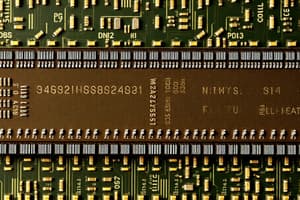Podcast
Questions and Answers
What is the first step in accessing memory using paging?
What is the first step in accessing memory using paging?
- Form the address of the Page Table Entry (PTE)
- Extract the Virtual Page Number (VPN) from the virtual address (correct)
- Check if the process can access the page
- Fetch the Page Table Entry (PTE)
What does the variable PTE represent in the context of memory access?
What does the variable PTE represent in the context of memory access?
- Virtual Address
- Access Permission
- Physical Address
- Page Table Entry (correct)
What is the consequence of having a PTE with the Valid attribute set to False?
What is the consequence of having a PTE with the Valid attribute set to False?
- No action is taken
- The process receives the physical address
- The memory access is allowed
- A segmentation fault exception is raised (correct)
What is the purpose of the OFFSET_MASK in the memory access process?
What is the purpose of the OFFSET_MASK in the memory access process?
What must be checked after fetching the PTE to ensure valid memory access?
What must be checked after fetching the PTE to ensure valid memory access?
What is the purpose of the code that initializes the array?
What is the purpose of the code that initializes the array?
What is the significance of the instruction 'incl %eax' in the assembly code?
What is the significance of the instruction 'incl %eax' in the assembly code?
What does the instruction 'cmpl $0x03e8, %eax' compare?
What does the instruction 'cmpl $0x03e8, %eax' compare?
How many pages are in the virtual address space given the assumptions?
How many pages are in the virtual address space given the assumptions?
What is the physical address of the linear page table?
What is the physical address of the linear page table?
Which instruction will not be executed if the comparison in 'cmpl' instruction fails?
Which instruction will not be executed if the comparison in 'cmpl' instruction fails?
What is the size of each page given the assumptions?
What is the size of each page given the assumptions?
What does the presence of virtual pages allow for in memory management?
What does the presence of virtual pages allow for in memory management?
What is the primary function of a page table?
What is the primary function of a page table?
How many bits are needed to track 1 gig page entries in a page table?
How many bits are needed to track 1 gig page entries in a page table?
What does the valid bit in a page table entry signify?
What does the valid bit in a page table entry signify?
Which bit in the page table entry indicates if a page has been accessed?
Which bit in the page table entry indicates if a page has been accessed?
What is the significance of the dirty bit in a page table entry?
What is the significance of the dirty bit in a page table entry?
What does the Present bit in a page table entry indicate?
What does the Present bit in a page table entry indicate?
What is the maximum size of a page in a system with a 32-bit address space and 4-KB pages?
What is the maximum size of a page in a system with a 32-bit address space and 4-KB pages?
In an x86 Page Table Entry, what does the R/W bit signify?
In an x86 Page Table Entry, what does the R/W bit signify?
What is the primary purpose of a page table in a paging system?
What is the primary purpose of a page table in a paging system?
How does paging differ from segmentation in terms of memory management?
How does paging differ from segmentation in terms of memory management?
In a simple paging system with a 64-byte address space and 16-byte pages, how many pages can fit in the address space?
In a simple paging system with a 64-byte address space and 16-byte pages, how many pages can fit in the address space?
What components make up the virtual address in a paging system?
What components make up the virtual address in a paging system?
What is an advantage of paging relating to free-space management?
What is an advantage of paging relating to free-space management?
Given a page size of 16 bytes and a virtual address of 2110, what is the offset within the page?
Given a page size of 16 bytes and a virtual address of 2110, what is the offset within the page?
In a paging system, what does a page frame represent?
In a paging system, what does a page frame represent?
Which of the following statements about virtual page numbers (VPN) is true?
Which of the following statements about virtual page numbers (VPN) is true?
In the example provided, how many page frames are there in the physical memory?
In the example provided, how many page frames are there in the physical memory?
What information does the offset within a page provide?
What information does the offset within a page provide?
What is one of the key characteristics of fixed-sized pages in paging?
What is one of the key characteristics of fixed-sized pages in paging?
If a virtual address has a virtual page number of 2 in a 64-byte address space with 16-byte pages, what is the physical address if page 2 is mapped to page frame 5?
If a virtual address has a virtual page number of 2 in a 64-byte address space with 16-byte pages, what is the physical address if page 2 is mapped to page frame 5?
Why is fragmentation not a significant issue in paging?
Why is fragmentation not a significant issue in paging?
Flashcards
Paging Memory Access
Paging Memory Access
Accessing memory using a page table to translate virtual addresses to physical addresses.
VPN
VPN
Virtual Page Number – part of the virtual address used to index the page table.
PTE
PTE
Page Table Entry – contains information about a page, including its physical frame number (PFN), access rights, and validity.
PTEAddr
PTEAddr
Signup and view all the flashcards
OFFSET_MASK
OFFSET_MASK
Signup and view all the flashcards
Page Table Size
Page Table Size
Signup and view all the flashcards
Page Table Entry (PTE)
Page Table Entry (PTE)
Signup and view all the flashcards
Virtual Page Number (VPN)
Virtual Page Number (VPN)
Signup and view all the flashcards
Page Frame Number (PFN)
Page Frame Number (PFN)
Signup and view all the flashcards
Valid Bit (PTE)
Valid Bit (PTE)
Signup and view all the flashcards
Protection Bit (PTE)
Protection Bit (PTE)
Signup and view all the flashcards
Present Bit (PTE)
Present Bit (PTE)
Signup and view all the flashcards
Page Table Structure (Linear)
Page Table Structure (Linear)
Signup and view all the flashcards
Paging
Paging
Signup and view all the flashcards
Page Frame
Page Frame
Signup and view all the flashcards
Page Table
Page Table
Signup and view all the flashcards
Virtual Address
Virtual Address
Signup and view all the flashcards
Physical Address
Physical Address
Signup and view all the flashcards
Offset
Offset
Signup and view all the flashcards
Address Translation
Address Translation
Signup and view all the flashcards
Memory Management
Memory Management
Signup and view all the flashcards
Segmentation
Segmentation
Signup and view all the flashcards
Advantages of Paging
Advantages of Paging
Signup and view all the flashcards
Virtual Memory
Virtual Memory
Signup and view all the flashcards
Page Table Location
Page Table Location
Signup and view all the flashcards
Virtual Memory Address (VA)
Virtual Memory Address (VA)
Signup and view all the flashcards
Physical Memory Address (PA)
Physical Memory Address (PA)
Signup and view all the flashcards
Page Size
Page Size
Signup and view all the flashcards
Virtual Page
Virtual Page
Signup and view all the flashcards
Linear Page Table Address (PA)
Linear Page Table Address (PA)
Signup and view all the flashcards
Memory Access
Memory Access
Signup and view all the flashcards
Array Initialization
Array Initialization
Signup and view all the flashcards
Study Notes
Paging: Introduction
- Paging divides the address space into fixed-size units called pages.
- Segmentation divides logical segments (code, stack, heap) into variable sizes.
- Physical memory is also divided into pages, called page frames.
- A page table per process is needed to translate virtual addresses to physical addresses.
Advantages of Paging
- Flexibility: Effectively abstracts address space without assumptions about heap and stack growth.
- Simplicity: Easy free-space management; page sizes (virtual and physical) are the same, avoiding fragmentation.
Example: Simple Paging
- 128-byte physical memory with 16-byte page frames (8 frames).
- 64-byte address space with 16-byte pages (4 pages).
- Shows page frames' contents with mapped virtual pages.
Address Translation
- Virtual addresses have two components: VPN (virtual page number) and offset.
- VPN determines which page in virtual memory.
- Offset determines the position of bytes within a page.
- Example: Virtual address 21 (binary 10101) in a 64-byte address space.
Example: Address Translation (Diagram)
- Shows how a virtual address 21 is translated into a physical address using a page table.
- The diagram maps the virtual page number to the physical page frame number to find the physical address.
Example: Page Table in Kernel Physical Memory
- Shows a page table with mappings between virtual page numbers to physical page frames.
Where Are Page Tables Stored?
- Page tables can be large (e.g., 32-bit address space with 4KB pages).
- 4MB = 220 entries * 4 bytes/entry = 20 bits are required to track 1 gig pages.
- Tables are stored in memory.
What Is In The Page Table
- A page table is a data structure that maps virtual addresses to physical addresses.
- It's a linear array (page table) indexed by VPN.
- The OS uses the VPN to index and retrieve the corresponding PTE (Page Table Entry).
Common Flags of Page Table Entry
- Valid bit: Indicates if the translation's valid.
- Protection bit: Defines read, write, and execute permissions.
- Present bit: Confirms if the page is in memory or on disk.
- Dirty bit: Indicates if the page has been modified since loading.
- Reference bit (accessed bit): Indicates whether the page has been accessed.
Example: x86 Page Table Entry
- Shows the common layout of an x86 page table entry (PTE).
- Includes fields for P (present), R/W (read/write), U/S (user/supervisor), A (accessed), D (dirty), and PFN (page frame number).
Paging: Too Slow
- Finding the desired PTE location requires the page table's starting address.
- Each memory access using paging involves an extra memory reference.
Accessing Memory with Paging
- Pseudocode shows how virtual addresses are translated to physical addresses using a page table.
Assumptions
- Address Space = 64KB
- Page Size = 1KB
- Number Virtual Pages = 64
- Linear page table located at physical address 1024.
A Virtual(And Physical) Memory Trace (Diagram)
- A diagram illustrating a virtual and physical memory trace showing how virtual addresses are mapped to physical addresses during memory access. The diagram often displays addresses and memory access patterns.
Studying That Suits You
Use AI to generate personalized quizzes and flashcards to suit your learning preferences.
Related Documents
Description
This quiz explores the fundamentals of paging, a memory management scheme that eliminates fragmentation by dividing the address space into fixed-size pages. You'll learn about the advantages of paging, its simplicity in free-space management, and how virtual addresses are translated into physical addresses. Test your understanding of virtual memory concepts with practical examples.




